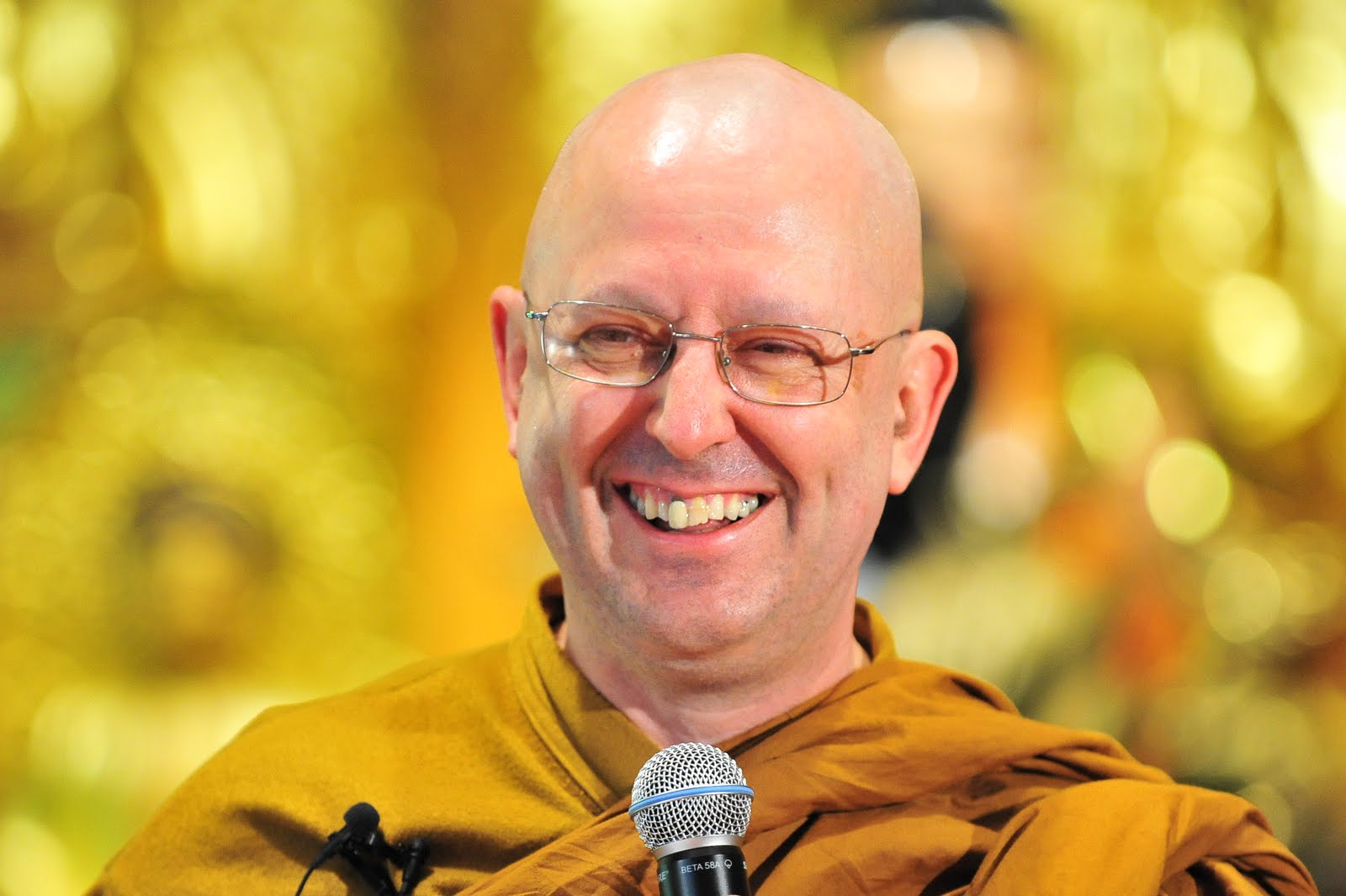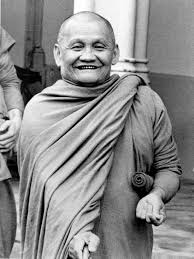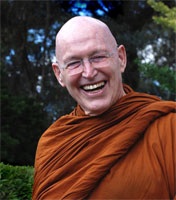Where is Enlightenment Today?
Sunday 22 May 2016
Back in the time of the Buddha, some 2600 years ago, in the foothills of the Himalaya’s, enlightened men and women seemed to be everywhere. The Buddhist Sutta’s talk about thousands of enlightened monks, teaching and meeting together with lay people, many of who are reported to have realised and apprehended the knowledge of the truth taught by the Buddha. Then there is the Theragarta --- a writing that records the thoughts of women at the time and it speaks of multitudes of enlightened nuns and women. In our world today with all of its wars, trouble and dissatisfaction it is easy to ask --- “Where are all the enlightened people today?” “Are there any --- Is it possible to be enlightened today?” We are suspicious even of our holiest teachers. Everyone has an angle! This cannot be denied. It is so even in my Buddhist circles where monks and nuns and the laity try very hard to practice and realise the truth of the Buddha’s enlightenment.
 There is a Monk at large named Ajahn Sumedho. He was one of my earliest teachers. His teacher was the famous Ajahn Chah, a purported enlightened Monk, who had set up an International Monastery in the North East of Thailand in the mid 70’s. After a period of being the Abbot at this monastery, Ajahn Sumedho moved to the UK and went on to set up a vast Buddhist Community under the banner of his teacher. He used to visit us regularly here in Perth, Western Australia, because the Buddhist Society of WA (BSWA) is a related Ajahn Chah Centre. We used to support each other. Ajahn Sumedho is senior to our well-known and much admired Ajahn Brahm, who is currently the Spiritual Leader of many Australian and International groups including the BSWA. Ajahn Brahm is also a famous disciple of Ajahn Chah and continues his tradition here in Perth.
There is a Monk at large named Ajahn Sumedho. He was one of my earliest teachers. His teacher was the famous Ajahn Chah, a purported enlightened Monk, who had set up an International Monastery in the North East of Thailand in the mid 70’s. After a period of being the Abbot at this monastery, Ajahn Sumedho moved to the UK and went on to set up a vast Buddhist Community under the banner of his teacher. He used to visit us regularly here in Perth, Western Australia, because the Buddhist Society of WA (BSWA) is a related Ajahn Chah Centre. We used to support each other. Ajahn Sumedho is senior to our well-known and much admired Ajahn Brahm, who is currently the Spiritual Leader of many Australian and International groups including the BSWA. Ajahn Brahm is also a famous disciple of Ajahn Chah and continues his tradition here in Perth.
Once when Ajahn Sumedho was leading a retreat, I can remember that he asked the very question that I have posed above. He said he would think --- “Where are the Ghandi’s and the Nelson Mandella’s.” --- “Where are all the noble human beings, the inspirational human beings today”. It seemed that everyone he would focus on had clay feet, and it was very demoralising. But continuing on, he said that when he was contemplating all of this he realised that he was projecting out into the external world. The external world is a place that he had already realised he had little control over. It was then he understood that if he wanted the world be enlightened, he would have to be enlightened himself.
This is a paradoxical thought but it is deeply engrained in Buddhist teachings. The Buddha himself said “Enlighten yourself and you will enlighten the world.” What does this mean?! I am sure the Buddha was being quite literal here, but we know when he was living as an enlightened person, the world did not become enlightened. So there is something deeper for us to see here. Something about “points of view” because I am sure that the Buddha’s world was enlightened.
 The answer to this vexed question comes when can start to see the nature of the external world and how we use our different perceptions to take from it what we are conditioned to take. We see the world with our individual mind streams locked in place and this will always create differences and cause trouble when we are dealing with others who are also locked into this paradigm of seeing the external world. However from the worlds point of view or we could say from Natures point of view the world is always in a state of perfection, it does not have trouble. It acts like it has no views and opinions and just allows the different energies to create, recede and settle in a natural way. So we can see that when we move to hold things in a certain “man-made” way we will always create tension in the energies as they respond to our desires and aversions. It is how the creative process works --- our minds moving to grasp onto and control what we desire while getting rid of that to which we are averse. There are a myriad of different ways that we all interpret and condition ourselves to this movement of consciousness --- there is limitless potential. This is what causes the different troubles in the world. The Buddha called it Dukkha and even wise and well-practiced monks are not immune from it and this is why I have introduced Ajahn Sumedho and Ajahn Brahm as protagonists to illustrate this fact about the external world. Both are undoubtedly great and highly respected Monks, but non-the-less, the different views held by these influential monks formed a deep schism in the Ajahn Chah tradition. More of this later, because now I want to explain how the practice of meditation can allow us to see the reality of what it is to be living as an individual being, locked into and dependent on the external world and how practice can bring it all to a stop in truth.
The answer to this vexed question comes when can start to see the nature of the external world and how we use our different perceptions to take from it what we are conditioned to take. We see the world with our individual mind streams locked in place and this will always create differences and cause trouble when we are dealing with others who are also locked into this paradigm of seeing the external world. However from the worlds point of view or we could say from Natures point of view the world is always in a state of perfection, it does not have trouble. It acts like it has no views and opinions and just allows the different energies to create, recede and settle in a natural way. So we can see that when we move to hold things in a certain “man-made” way we will always create tension in the energies as they respond to our desires and aversions. It is how the creative process works --- our minds moving to grasp onto and control what we desire while getting rid of that to which we are averse. There are a myriad of different ways that we all interpret and condition ourselves to this movement of consciousness --- there is limitless potential. This is what causes the different troubles in the world. The Buddha called it Dukkha and even wise and well-practiced monks are not immune from it and this is why I have introduced Ajahn Sumedho and Ajahn Brahm as protagonists to illustrate this fact about the external world. Both are undoubtedly great and highly respected Monks, but non-the-less, the different views held by these influential monks formed a deep schism in the Ajahn Chah tradition. More of this later, because now I want to explain how the practice of meditation can allow us to see the reality of what it is to be living as an individual being, locked into and dependent on the external world and how practice can bring it all to a stop in truth.
Deep mediation allows a focus profound into the present moment. The Buddha said that the present moment is where truth and enlightenment live. The path to truth is in the practice and enlightenment is its fruit. Uncovering the present moment is the work of our meditation. To say this in a more practical way we can say that right practice allows us to see and know our personal stream of consciousness. We can see how our consciousness is conditioned into our personality and self. Then looking more deeply past the conditions of the personality working in our minds we can eventually see the still consciousness that forms emptiness and the space that contains the conditions. We notice that when this this still consciousness moves it aggregates in a nested way to form the conditions that we attach ourselves to. So it is a creative energy when attachment puts it under tension. However we also see that it is penetrating energy such that if we “let go” the conditions they will relax and finish back into the still consciousness.
The Buddha told us that this still consciousness “too” is a condition and he instructed us to keep uncovering the moment with mindfulness until the still consciousness “too” has finished. For practitioners this can be confusing to sort out, but when it is done beyond any doubt, the practitioner will know what the Buddha called Cessation. The practitioner will know what it is to have stopped. Enlightenment will be available for this practitioner when the pathway to stopping is perfected. When a person who has stopped finally dies, there will be no rebirth. The pathway to peace is complete and the external world that has hitherto supported the rebirth of this particular mind-stream will also finish, thus the paradox is resolved. We can now see that the world we live in cannot be enlightened until we are. My world cannot be enlightened until I am.
Back to the story of the schism! In September 2009 Ajahn Brahm moved to fully ordain and reinstate Nuns into the Theravada tradition. He made it possible to ordain four nuns who had ordained to the limit that women could go to then. They were living at the new nuns monastery set up by the BSWA. There was a movement of senior monks from North East Thailand who were opposed to the reintroduction of fully ordained Nuns. They think the broken lineage cannot be reinstated. Ajahn Chah had been dead since 1992 following a 10 year coma, and this was not an issue he had spoken of. This did not of course stop both sides from harnessing him into their team. Ajahn Sumedho was influenced more by his senior peers than Ajahn Brahm, so when the ordinations went ahead a schism appeared. The worlds conditioning had its effects, even on these two wise Monks. It had to! Even though it is likely that both these monks know what it is to have stopped, they still live in the world and its conditioning will have its affect. Both monks were under tremendous pressure from the respective sides.
 I believe that we can assume the Universe was indifferent to the rights and wrongs of this event, in that the energy it carried would have played out naturally. The exception is the extent to which the individual mind streams of all the parties involved worked to put the energy that they had some access to under tension to either prove they were right or to punish the other side. This is not to belittle the events or indeed to make a “God” like pronouncement of who is right or wrong. (For the record, I have always supported the BSWA’s push to re-establish fully ordained Theravada Buddhist Nuns in the world again.) The point is to illustrate that when the external world is active as a “dissociated force” (unseen force) in our minds, the conditioning it carries will always be reborn. As mentioned before the Buddha called it and its results “Dukkha”. This Dukkha is part of normal everyday awareness and the Buddha described it as “Mundane” life. The Buddha lived forty years as an enlightened monk, but his enlightenment did not make him immune from trouble. The difference is that he spoke of his life as “Supra Mundane” His consciousness was above conditioning. He had access to cessation. This is an important realisation. I do not know whether or not the minds of Ajahns Sumedho or Brahm are conditioned to stop --- like the Buddha’s, so it is always difficult to judge these things, and even if they thought they knew, they would be unwise to say so. That is why it always comes back to what Ajahn Sumedho realised at the start --- “you need to be enlightened yourself”. Then, like the Buddha, you will know!
I believe that we can assume the Universe was indifferent to the rights and wrongs of this event, in that the energy it carried would have played out naturally. The exception is the extent to which the individual mind streams of all the parties involved worked to put the energy that they had some access to under tension to either prove they were right or to punish the other side. This is not to belittle the events or indeed to make a “God” like pronouncement of who is right or wrong. (For the record, I have always supported the BSWA’s push to re-establish fully ordained Theravada Buddhist Nuns in the world again.) The point is to illustrate that when the external world is active as a “dissociated force” (unseen force) in our minds, the conditioning it carries will always be reborn. As mentioned before the Buddha called it and its results “Dukkha”. This Dukkha is part of normal everyday awareness and the Buddha described it as “Mundane” life. The Buddha lived forty years as an enlightened monk, but his enlightenment did not make him immune from trouble. The difference is that he spoke of his life as “Supra Mundane” His consciousness was above conditioning. He had access to cessation. This is an important realisation. I do not know whether or not the minds of Ajahns Sumedho or Brahm are conditioned to stop --- like the Buddha’s, so it is always difficult to judge these things, and even if they thought they knew, they would be unwise to say so. That is why it always comes back to what Ajahn Sumedho realised at the start --- “you need to be enlightened yourself”. Then, like the Buddha, you will know!
So where are all the enlightened beings today? Perhaps this question is one that can only be answered with hindsight. Even the Buddha maintained a noble silence when asked to describe enlightenment. There are however many good, fine balanced and impeccable people living on the earth today. One notices them more and more as personal practice deepens. Master practitioners like Ajahns Brahm and Sumedho are certainly people who exemplify the Buddha’s teaching but like everyone else, they are still subject to the worlds conditions until their personal mind streams finish in cessation at their death. Just like the rest of us!






